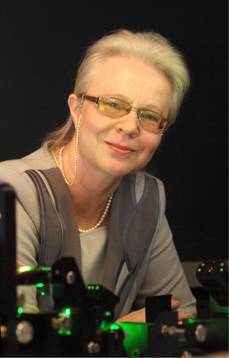|

|
Professor Olga Kocharovskaya
Department of Physics and Astronomy, Texas A&M University
|
Abstract: Can light be transmitted through a resonantly absorbing opaque medium? Can it be amplified or even generated without population inversion? Can it slow down or even hold for seconds and be released on demand? Usually, the answer is always no. However, this answer can be yes if you shine a control light of different color (i.e., different frequency) resonant to an adjacent transition in the same medium. The counterintuitive effects of electromagnetically induced transparency, lasing without population inversion and “stopped” light” were predicted by our research group and became the subject of heated discussions in the 1990s. These effects have become the textbook example of dramatic modifications of the light-matter interaction by applying a control light and led to numerous devices, such as such as precise atomic clocks, high-sensitive magnetometers, coherent THz-radiation sources, etc.
This presentation will be focused on the new dynamical methods to control light by light. In this case the resonant interaction of signal light with the medium is altered by an intense low-frequency field resulting in modulation of the atomic frequency via adiabatic linear/quadratic Stark effect and/or interruption of resonant interaction via tunneling ionization. It results in a number of new effects such as modulation induced transparency, frequency comb production and formation of the extremely short pulses in various ranges of frequencies from VUV till X-ray range. These effects lead to high impact applications in the diverse fields of multidisciplinary research and modern areas of technological development, including ultrafast cameras allowing one to watch electron’s dancing in atoms, and molecules and quantum memory devices for the long distance quantum optical communications.
About the Speaker: Olga Kocharovskaya is the Distinguished Professor in the Department of Physics and Astronomy, Texas A&M University. She joined the Texas A&M faculty in 1998 after 12 years at the Institute of Applied Physics of the Russian Academy of Sciences. She made a number of seminal contributions to laser science and quantum optics. These include the predictions of the phenomena of electro-magnetically induced transparency and lasing without inversion as well as suggestion and experimental realization of the various schemes for coherent control of gamma-ray nuclear transitions. Her pioneering works initiated the broad and fast growing fields of research. A fellow of both the American Physical Society and Optical Society of America, she has earned the Willis Lamb Medal for Laser Physics and Quantum Electronics, the Sigma Xi Distinguished Scientist Award, the Texas A&M Association of Former Students Distinguished Achievement Award in Research and the Texas A&M University Distinguished Professor Award.
Date&Time: October 10, 2014 (Friday), 10:00-11:00 a.m.
Location: 606 Conference Room, No.3 Heqing Road, Haidian District


